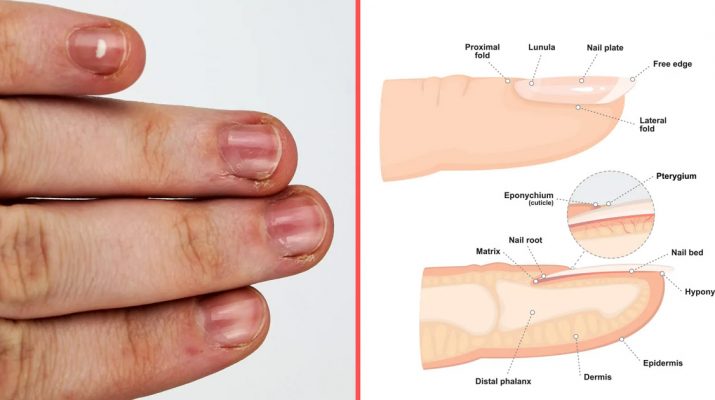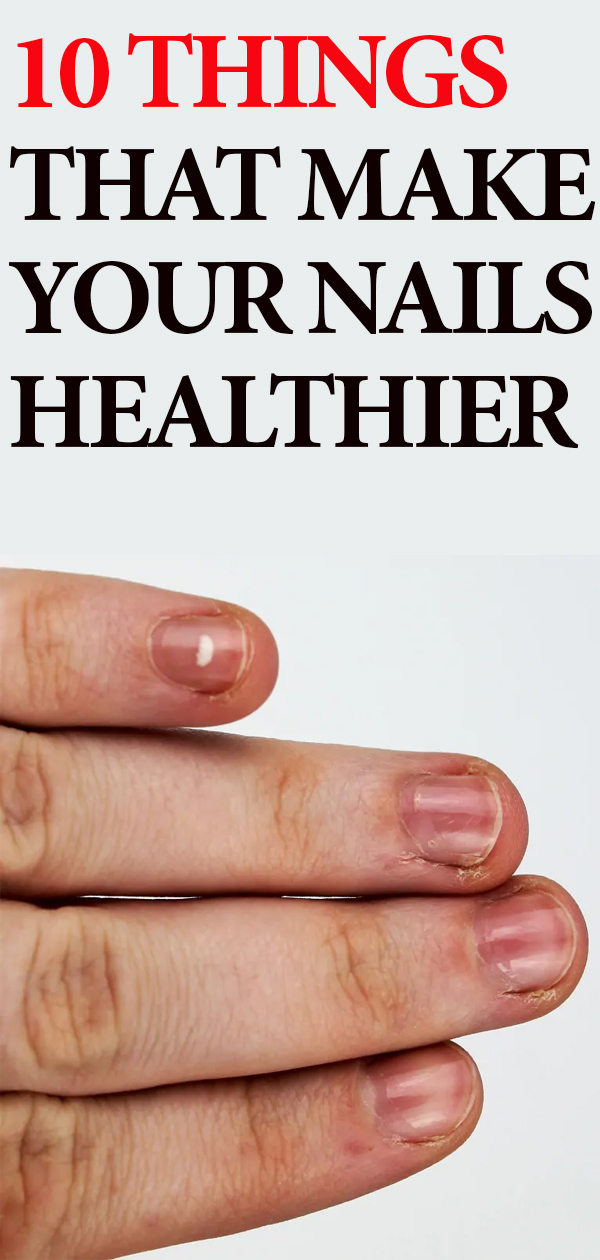Fingernails can serve as a visual indicator of our health, says the American Academy of Dermatology (AAD). It behooves us, then, to care for our nails, and if need be, make our nails healthier.
Do you know why we have nails? No, it isn’t to serve as a backscratcher or homemade guitar pick (trim those things before you hurt someone!)
“Well, to protect our precious fingers and toes!” you may say. While certainly a good guess, it’s not the correct one. But you do bring up an excellent point. Keratin, a hardened protein that constitutes multiple layers inside of the nails, helps protect our (and other primates’) soft tissues of the fingers and toes.
In fact, we have nails because of the biological order, primates, to which we belong. Other primates include apes, lemurs, and monkeys. Something else you’ll notice about primates is that they all have five fingers and opposing thumbs, as well.
So, evolutionary anthropologists and biologists, along with other experts, posit that our fingernails and toenails are essentially claws. “Most mammals have claws,” says biological anthropologist John Hawks, adding that most mammals use these special features to “grab onto … climb … scratch … (and) to dig holes.”
Scientists believe that we primates adopted flatter, broader fingertips to aid movement. We can see this in our primate brethren, who are able to traverse rainforest canopies effortlessly; something they would have much more trouble doing with long claws.
There is one other reason why we developed fingernails: to serve as a visual indicator of our health, says the American Academy of Dermatology (AAD). It behooves us, then, to care for our nails and keep them healthy.
If you’ve been doing a subpar job caring for your fingernails, or need someone to show you how, you’ve come to the right place! We’ll focus our attention here on things that will make your nails healthier. We’ll also discuss why you may want to reconsider a seriously unhealthy splurge.
Let’s get to it!
Things That Make Your Nails Healthier
Here are ten things that make your nails healthier:
-
Biotin
Biotin, also known as coenzyme R, vitamin B7, and vitamin H, helps promote healthy skin growth while aiding in the metabolization of amino acids necessary for protein synthesis.
Research indicates that biotin may help to strengthen brittle nails. In a study of 35 people, participants who consumed 2.5 milligrams (mg) of biotin over a 1 ½- to 7-month period experienced a 63 percent reduction in the number of symptoms associated with brittle nails.
The recommended daily allowance (RDA) for biotin is 30 micrograms (mcg) per day. Biotin-rich foods include liver and other meats, egg yolk, yeast, nuts and seeds, salmon, dairy, avocado, and sweet potato.
-
Petroleum Jelly
Per the American Academy of Dermatology, petroleum jelly is excellent for rehydrating your nails. As we’ll discuss later, the products often used in nail salons are counterproductive to nail health. One reason for this is that many professional nail products will dehydrate the nails. If you frequent nail salons, consider applying petroleum jelly to the nails and cuticles regularly.
Besides providing hydration to the nails, petroleum jelly will also help to prevent nail chipping and brittleness. You should not apply petroleum jelly to dry nails. For the best results, apply the product when your nails are damp.
-
B Vitamins
Vitamin B12 helps the body absorb iron, which in turn ensures the proper delivery of nutrients to the nails. Another B vitamin important for making your nails healthier is folate (B9), which aids with nail growth. The RDA for both B vitamins is 2.4 mcg for B12 and 400 mcg for B9.
Folate is found in beans, citrus fruits, lentils, avocado, nuts, peas, and seeds. B12 is primarily found in meat, fish, poultry, dairy, and eggs. Vegetarians may wish to supplement B12.
-
Iron
As mentioned, iron is critical for the delivery of oxygen and, therefore, nutrients, to the nails. The RDA for iron varies considerably depending on age, gender, and other conditions. Most people should take between 8 to 18 mg.
Foods rich in iron include shellfish, spinach, legumes, and pumpkin seeds.
-
No Polish
As we’ll get to shortly, nail salons are a dirty business – both in terms of actual business practices and the toxic fumes wafting around. We’ll focus on the latter here.
Nail polish is slathered on in salons. While the product may look pretty, polishes are rife with harmful chemicals like acetone. Acrylics, nail polishes, and nail polish removers all contain substances that can dehydrate and damage your nails.
-
A Good Nail File
First things first, you want to trim your nails before filing. Trim each nail in a straight line before curving the tips.
Next, use a nail file with the appropriate file grade. The exact file that you use doesn’t matter too much, provided that it doesn’t rough up the skin around your nails. A medium-grit file (180 to 220 grit) is preferred by many manicurists for general smoothing and shaping.
Finally, make sure that you file unidirectionally. That is, don’t saw back and forth as this can weaken both the nail and the surrounding areas.
-
Magnesium
Magnesium, “Mg” on the periodic table, is involved in over 300 reactions in the body, including protein synthesis, which is needed for proper nail growth. Not getting enough magnesium can lead to ridging of the nails as well.
The World Health Organization (WHO) estimates that up to 4o percent of the U.S. population is deficient in magnesium. The RDA for magnesium is 310 to 320 mg for women and 400 to 420 mg for men, respectively.
Food sources of magnesium include almonds, cashews, dark leafy greens, edamame, and black beans.
-
No Nail Hardeners
This article hasn’t exactly been unsparing to the nail products industry, so why not add another “no-no” to the list? Nail hardeners.
Don’t buy them. Nail hardeners, like most nail “care” products, haven’t been studied in a laboratory and scientifically validated. Would you put something in your body that you knew hasn’t been appropriately tested?
-
Protein
As mentioned, the substance that gives nails their firmness is keratin, which is a structural protein. Without it, our nails would be susceptible to all kinds of damage. As such, consuming adequate protein is critical for increasing keratin production and creating strong nails.
The RDA for protein is 0.36 grams per pound or 0.8 grams per kilogram (kg) of body weight. Foods rich in protein include animal products like eggs, dairy, fish, meat, and poultry, and the plant foods beans, legumes, lentils, nuts, seeds, soy, and whole grains.
-
Vitamin C
Vitamin C drives the production of collagen, a protein critical to the formation of elongated fibers that make up connective tissue. Collagen is crucial to nail formation, shape, and strength.
The RDA for vitamin C is 75 and 90 mg for women and men, respectively. The best sources of vitamin C are citrus fruits like grapefruit, lemons, and oranges. Other good sources of “C” include bell peppers, green vegetables, and tomatoes.
Final Thoughts: Avoid Nail Salons And Other Nailcare Tips
“The study provides some of the first hard evidence that these environments are dangerous for workers and that better policies need to be enacted to protect them.” – Lupita Montoya, lead author/Research Associate at the University of Colorado.
Besides most nail polishes being toxic, it turns out that nail salons are one of the most noxious places that you can visit.
In a study titled “Occupational exposure to volatile organic compounds and health risks in Colorado nail salons,” published in the journal Environmental Pollution, researchers observe the following:
“Nail salon technicians face chronic exposure to volatile organic compounds (VOCs), which can lead to adverse health outcomes including cancer.”
The research team performed three key measurements:
(1) The indoor levels of VOCs – benzene, ethylbenzene, formaldehyde, toluene, and xylene
(2) Estimated VOC exposure levels of nail salon technicians
(3) A VOC measurement and healthy questionnaire administered to 20 nail salon workers
After Analyzing The Data, The Research Team Found The Following:
- Approximately 70 percent of all nail salon workers experience at least one health issue directly resulting from their vocation.
- Elevated concentrations of formaldehyde in all six salons studied. Formaldehyde exposure is linked to an increased risk of multiple cancers and leukemia.
- Workers are up to 38 times more likely to develop cancers of the nose and throat, and up to 135 times more likely to develop leukemia.
Let’s be clear about one thing: these findings aren’t written here to dissuade anyone from visiting their favorite nail salon. As far as health risks go, the study doesn’t mention patrons, just those who work in nail salons.
But the study should warrant a bit of concern. If not for health reasons, then perhaps for the rampant economic exploitation.
To Wrap Things Up, Here Are Some Tips To Make Your Nails Healthier:
Keep ‘em clean and dry: Thoroughly clean and dry the surface of and underneath your nails. This helps to prevent bacterial growth and troublesome conditions like split nails.
Moisturize: Skin is prone to dryness, particularly in less humid environments. Use lotion to counteract this drying effect. Exposure to cold, heat, harsh soaps and the sun can also contribute to dry skin.
Practice good nail hygiene: Use only sharpened manicure clippers or scissors. Trim your nails straight across and gently curve the tips.


